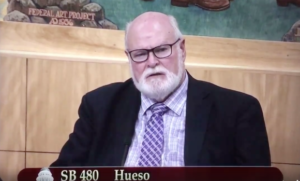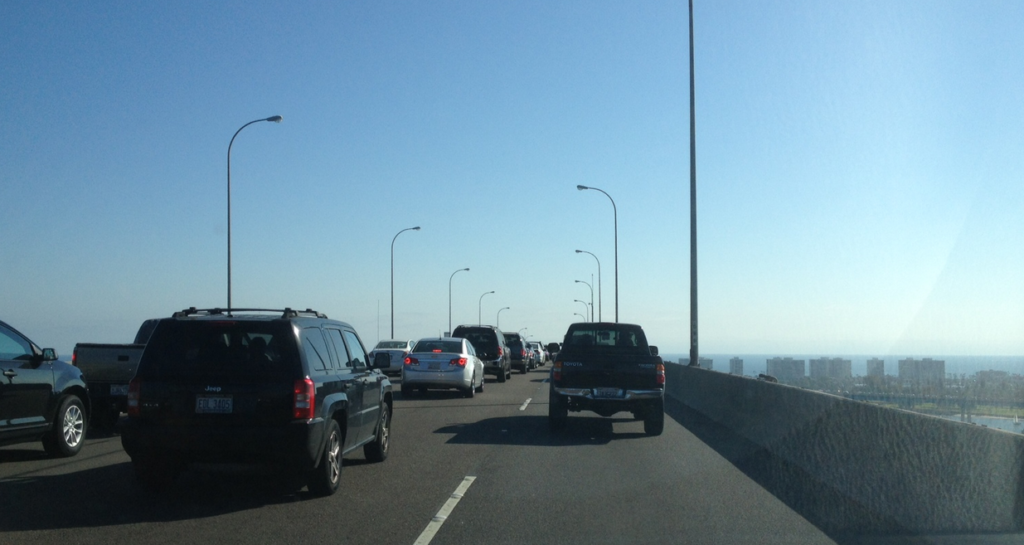

As the number of deaths from suicides and vehicles falling off the San Diego-Coronado Bay Bridge reaches a horrifying and historic number, senators in Sacramento pass a bill to move forward with safety improvements, so #NotOneMoreLife will be lost as a result of the unsafe structure.
“Why isn’t this a priority for CalTrans?” questioned Senator Jim Beall during a recent Sacramento Transportation Committee Meeting. “How come they haven’t even commenced an investigation of why people are committing suicide or why a truck falls off and kills people.”
Hanging his head, Senator Ben Hueso responds, “I would have liked to have seen this be resolved years ago. We need a solution to this and this bill will help us come up with a permanent solution that we can work on implementing in the future.”
Just as quickly as the death toll reached 400, since the blue bridge was built in 1969, another jumper’s name was added to the long and rapidly growing list of fatalities as a result of the low rise walls and non-existent suicide prevention barriers. This brings the total death count from suicide or vehicles falling off the bridge to 401.
According to Rhonda Haiston, Founder of the Coronado San Diego Bridge Collaborative for Suicide Prevention, and the San Diego Medical Examiners office, there have been 391 deaths from suicide on the bridge, as of March 30, 2017. This does not include persons killed by cars flying off the bridge onto people in the park below, nor does it include homicides and general traffic related deaths that have occurred on the bridge.
Since the first quarter of 2017 there have been several more individuals who have taken their lives by jumping from the bridge, bringing the total bridge related deaths from all causes to 401. Here is a breakdown of some suicide statistics since 2011, as there has been an average of a 50% increase compared to previous years.
Year: Total Suicide Deaths:
2011 10
2012 19
2013 14
2014 15
2015 13
2016 17
2017 *5 (as of March 30, 2017)
*A revised number will not become available until the first week of July 2017, which will include the deaths that have occurred in the 2nd quarter of this year.
The President of the Coronado San Diego Bridge Collaborative for Suicide Prevention, Wayne Strickland, shared the news of the bill’s passing with Coronado council members and residents during a recent city meeting.
“I just want to share some good news,” says Strickland. “CalTrans is going to do a high level feasibility study for the suicide barrier. They will share the details with us as soon as they have more info. So, it’s going to be done!”

While local representatives work to hold Laurie Berman, District 11 CalTrans Director, accountable for moving forward, quickly, with the study and barrier implementation, members of the public, including Dustin Semple and his engineering team at SDSU, are providing design input that will be considered throughout the entire process. His design for the barrier includes long steel pipes running horizontally inside the fence to prevent cars from going over the bridge, as well.

According to local representatives, on average, 77,000 trips are made across the San Diego-Coronado Bay Bridge daily. The massive blue structure is a main artery that connects two of California’s largest military bases. As drivers make their way across the bridge, traffic is frequently halted due to a “stalled vehicle” at the bridge’s highest point.
A former San Diego resident, Carl Glass, a Lieutenant Commander for the United States Navy, recalls the time he encountered a stalled vehicle on the bridge. “As we crossed the bridge from San Diego to Coronado we noticed what looked like a stalled car blocking the right lane at the crest of the bridge. Traffic was still moving pretty quick; it was obvious the car hadn’t been there for that long. Nothing atypical about the fact that no one was really stopping to help… people probably figured the driver was already on the phone with a tow truck.”
As we pulled up to the car, we could see that even though the hazard lights were on, the hood wasn’t up, and the owner was just standing at the edge of the bridge in front of his car, his arms spread out and resting on the ledge, with his head down looking at the water.
Glass continues, “It was pretty clear at that point that he wasn’t having car issues, but I and the driver immediately in front of me already had our windows down to ask the guy if he needed assistance. He answered the car in front of me by just looking up at the driver and slowly shaking his head, then going back to looking at the water. At that point it dawned on me what was really going on. I was actually a little surprised that he’d consider jumping in on the middle of the day.”
“The car in front of me and I pulled over to the right, just in front of the guy and his car. I gave my wife my phone and told her to call 911 to report a jumper on the bridge, and I got out and ran back to the guy. The biggest point to make here is that by the time I got there, there were already two people: one guy, one girl, both probably in their mid-twenties, who had stopped (one was the driver of the car in front of me) and were already standing right there with the prospective jumper. The two of them were on either side of the young man, and the male Samaritan had his arms around the jumper’s shoulders—not to restrain him, but as one would to talk closer into someone’s ear. Added to that, the three of them had taken a step back so they weren’t right up against the ledge anymore, so it seemed unlikely to me that this guy was actually going to jump.”
As for the outcome of the situation, Glass says the individual was handcuffed by a CPD officer and escorted to the back of a patrol car.
“The focus was getting the traffic flowing, so the CHP officers asked the three of us if anyone could drive the guy’s car down off the bridge,” says Glass. “I ran up and told my wife to drive our car down to the parking lot at the base of the bridge, and then I got in the guy’s car. It was a little surreal… the car was a mess, full of textbooks and CDs and just regular daily life stuff. The guy’s iPhone was still trying to give directions.”
He had set the destination to the middle of the bridge, so it was telling me to make a U-turn at the next opportunity to get back up there – says Glass.
Glass recalls being impressed by two things during the ordeal. “First, by the time I got to the prospective jumper, there were already two police boats in the water under the bridge. Literally, those guys were on the scene within two minutes. The second impressive thing was the police response on the bridge itself. The first patrol car arrived in the eastbound lane (from the Coronado side) probably within three minutes of us initially pulling over. The CHP officer hopped across the median and came over to us. His first question to the individual struck me by surprise: the officer asked him if he’d been up there before, to which the guy nodded his head. He asked us a few questions but his focus was getting traffic flowing across the bridge again (the second patrol car finally stopped traffic completely). At this point, I think a total of maybe five minutes had elapsed. No more than six. Pretty impressive, in my opinion. The flip side is, their response time is probably a function of how often that kind of thing happens on the bridge, so it’s also kind of a shame.”
And while Glass recounts, during an interview with The Coronado Times, the events that transpired as he witnessed a near suicide attempt a little over one year ago, other members of the community are expressing their experiences in other ways. Collin Leslie, a masters student in the cinematography department at SDSU, recently created a film that captures emotions from victims’ family members as well as witnesses to jumps from the bridge. You can watch his video below:
https://vimeo.com/212835959
The 3rd annual San Diego-Coronado Bay Bridge Memorial will be held at Tidelands Park on Sunday, June 4, 2017 from 6:00pm to 7:00pm. Residents are asked to join the Coronado San Diego Bridge Collaborative for Suicide Prevention and Sacred Heart Parish’s Father Mike to honor those we’ve lost to the bridge, but whom are in no way forgotten.




